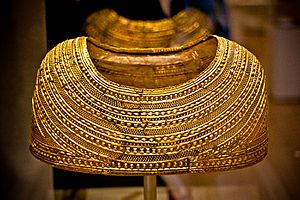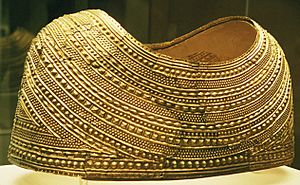Mold cape facts for kids
Quick facts for kids Mold cape |
|
|---|---|
|
The Mold cape in the British Museum
|
|
| Material | Gold |
| Created | 1900–1600 BC |
| Discovered | Mold, Wales in 1833 |
| Present location | British Museum |
The Mold cape is a special object made from solid gold. It was created a very long time ago, between 1900 and 1600 BC, during the Bronze Age in Europe. It was discovered in Mold, Wales, in the year 1833.
People think the cape was part of a special outfit worn for important ceremonies, maybe even for religious events. Today, you can see it at the British Museum in London.
Contents
How the Mold Cape Was Found
The gold cape was found in 1833 by workers in Mold, Wales. Some stories say they were digging for gravel, while others say they were quarrying for stone.
Discovery in a Burial Mound
The cape was inside an ancient burial mound. This mound was in a field called Bryn yr Ellyllon, which means "Fairies' or Goblins' Hill." The gold cape had been placed on the body of a person buried in a simple stone-lined grave. This grave was inside the burial mound.
What Else Was Found?
The skeleton found with the cape was in small pieces. The cape itself was also badly crushed. Experts believe there were once 200 to 300 amber beads on the cape, arranged in rows. But only one bead remains at the British Museum today.
Other items found included bits of rough cloth and 16 pieces of thin bronze. These bronze pieces likely formed a backing for the gold, with small bronze rivets holding the gold onto the bronze. Two gold "straps" were also found. About 60 to 90 centimeters away from the grave, an urn filled with burnt bones and ash was discovered.
Who Wore the Cape?
The cape is about 458 millimeters wide. It was made for someone with a very slender body. Even though we don't know if the person buried was a man or a woman, other similar graves from that time suggest it was likely a woman.
About the Mold Gold Cape
The Mold cape is one of the most amazing examples of ancient gold work ever found. It's very special because its shape and design are unique. The cape is oval and would have covered the shoulders, upper arms, and upper chest of the person wearing it. It was higher at the back and lower in the front.
Amazing Craftsmanship
The way the cape was made is truly exceptional. It was hammered out of a single piece of gold. This would have taken a huge amount of time and skill. Then, it was decorated with many raised, circular patterns called repoussé rings and bumps. These decorations cover almost the entire outer surface, leaving very little plain gold. Some people think these patterns might look like many strings of beads or even folds of cloth.
Value and Purpose
The high value of the gold and the incredible skill used to make it show that the cape came from a very rich culture. Experts think the people who made and owned the cape might have been connected to the mine on the Great Orme in North Wales. This was the biggest copper mine in northwest Europe at that time.
The cape would have gone so far down the wearer's body that it would have made it hard to move their arms. Only their lower arms would have been free. Because of this, people believe the cape was not for everyday wear. It was most likely used for special ceremonies. It probably showed that the wearer was a very important person with spiritual or powerful status. It was like a special robe for someone important in the Bronze Age.
Other Similar Gold Items
The Wessex region of England was known for its rich grave goods during the Bronze Age. Many graves there, especially about 15% of them, contained beautiful gold items. Fifteen places in Wessex have yielded gold items, compared to only five in four other southern English counties. There seems to be no gold found in the rest of the country.
Wessex Goldwork
Many experts believe that much of the gold from Wessex was made by one very skilled craftsman or his workshop. The Mold cape is the only other piece of Bronze Age gold that is as rich and impressive as the Wessex items. However, the patterns on the Mold cape are different from those found in Wessex.
Influences on the Mold Cape
The Mold cape shows influences from both local styles and ideas from other parts of Europe. Similar decorative patterns can be seen on other Bronze Age metal items. For example, a bowl found in Rongères, France, has similar designs that came from Central Europe. Also, the raised bumps on the Migdale "spacer-plate" from Scotland and bronze armlets from Melfort, Scotland, show similar patterns. This special bump design, outlined with tiny dots, was used for a long time in Scotland. It clearly appeared again on this unique Mold cape.
Later Goldwork
With its detailed repoussé work (where designs are hammered from the back), the Mold cape is the last major piece of thin gold sheet work found from the second millennium BC. After this time, people in the British Isles preferred to make heavy, solid gold items. These included solid bracelets, twisted neck rings called torcs, and solid rings.
Finding and Displaying the Cape
Because its bronze backing had fallen apart, the delicate cape broke into pieces when it was found. These pieces were spread among different people. The British Museum bought most of the pieces in 1836. However, small fragments have been found over the years and added back to the main part of the cape.
Later, detailed study and careful repair helped put the cape back together. At one point, people thought it was a chest ornament for a horse! It also became clear that a second, smaller object with matching patterns was in the grave. Today, the cape is mounted on cloth to protect it.
Famous Appearances
The Mold cape was chosen as number 6 on a list of top British archaeological finds. Experts at the British Museum picked it for a BBC Television documentary called Our Top Ten Treasures in 2003. It was also featured in the BBC Radio 4 series A History of the World in 100 Objects in February 2010, as object number 19.
The cape was on display at the National Museum of Wales in Cardiff until August 4, 2013. Then, it moved to Wrexham from August 7 to September 14, 2013.
Images for kids
See also
 In Spanish: Capa de oro de Mold para niños
In Spanish: Capa de oro de Mold para niños




